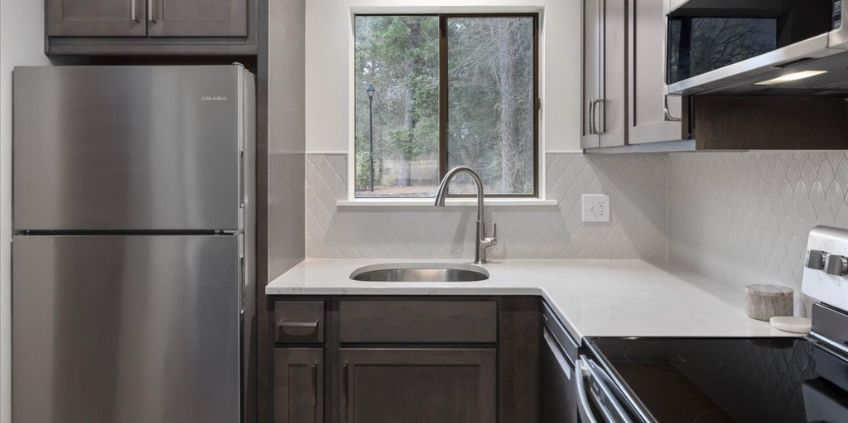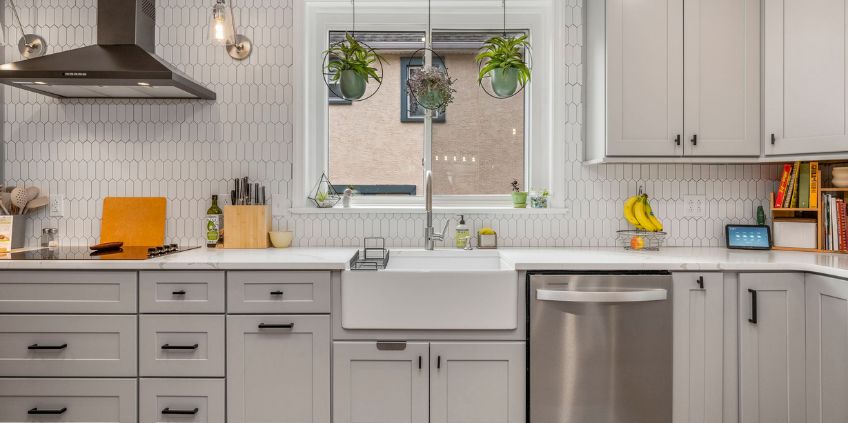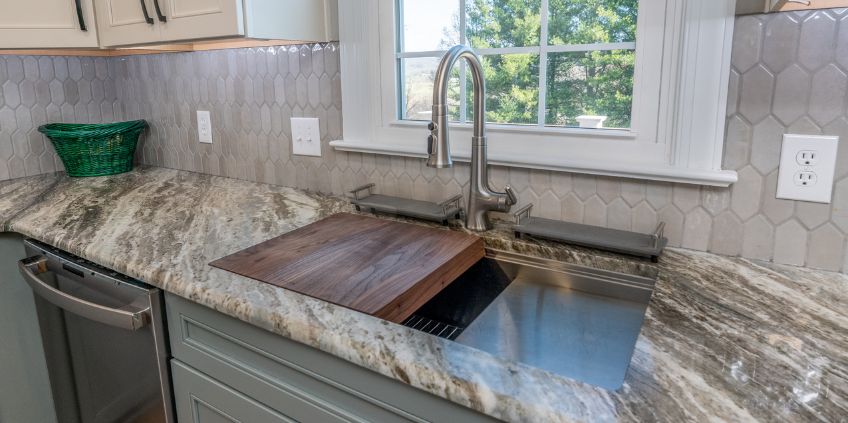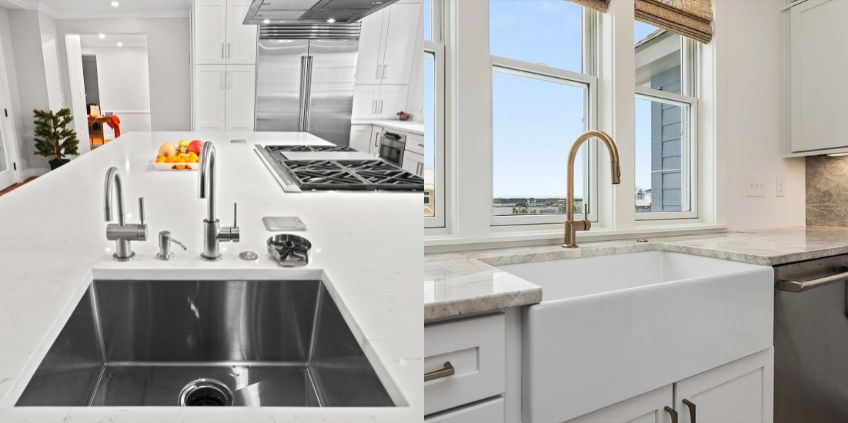If you’re planning a kitchen remodel or simply replacing your old kitchen sink, it won’t take long before you realize: the options are overwhelming. With different materials, styles, sizes, and configurations, narrowing it down can feel like a chore.
But don’t worry—we’re here to help. This guide covers four essential factors to consider when choosing the perfect kitchen sink, with links to deeper dives on each topic so you can make the most informed decision for your space.
1. Kitchen Sink Material

What your kitchen sink is made of affects more than just aesthetics. It plays a key role in how your sink performs day to day—including how well it holds up to scratches, stains, heat, heavy pots and everyday use. Let’s break down some of the most common materials:
- Stainless Steel: Timeless, versatile, and budget-friendly, a stainless steel sink remains a top choice for many homeowners. It blends seamlessly into both modern and traditional kitchens and resists rust and heat. Look for lower-gauge steel (16–18 gauge) for less noise and added durability. A sound-deadening undercoating can also help reduce clanging.
- Fireclay: Made from molded ceramic and fired at extremely high temperatures, fireclay sinks offer a smooth, glossy surface that’s resistant to chips, scratches, and discoloration. Its farmhouse appeal fits beautifully in cottage or classic kitchens. Just be mindful of potential chipping if a heavy pan gets dropped.
- Composite: A mix of stone dust and resin, composite sinks are non-porous, heat-resistant, and available in a range of earthy tones. They're also quieter and less prone to showing water spots compared to stainless sink material. Ideal for busy households that want durability with style.
- Natural Stone and Quartz: These sinks deliver premium elegance and make a bold design statement. But they can be more fragile, require special care, and often come with a higher price point and added weight.
- Copper: Eye-catching and unique, copper has natural antimicrobial properties but requires regular polishing to enhance and maintain its patina—or you can let it age naturally for a rustic look.
Tip: When choosing the right sink material for your home and kitchen, think about your habits—do you cook daily, entertain often, or rely heavily on a dishwasher? Choose something that complements your lifestyle, not just your décor.
2. Kitchen Sink Style

The way your kitchen sink is installed affects not just its appearance, but also how it interacts with your countertops and cabinetry—and how easy it is to clean.
- Drop-In (Top Mount) sink: Traditionally, this sink is a very common and budget-friendly style. The sink drops into a hole cut into your countertop, with a visible rim that rests on the counter. It's easier to install but can collect grime along the edges.
- Undermount sink: Attached beneath the counter, this option offers a sleek look and makes it easy to wipe crumbs or spills directly into the sink—especially useful with stone or solid-surface countertops. It does require professional installation and isn't ideal for laminate.
- Apron-Front (farmhouse sink): Featuring an exposed front panel that juts slightly past the cabinetry, this style is both functional and decorative. Also referred to as a farmhouse sink, its' style creates a striking visual centerpiece and offers a deeper basin, but requires thoughtful design and careful planning
- Integral Sink: A seamless, all-in-one sink and countertop made from the same material, most commonly found with solid surface. Great for a minimalist look and easy cleanup, though less common and more expensive.
Tip: If you’re remodeling your entire kitchen or your entire countertop, now’s the time to upgrade to an undermount or apron-front style. Otherwise, your options for replacing an existing sink without redoing countertops at minimum is limited.
3. Kitchen Sink Configuration

Think about how you cook, clean, and share your kitchen space. Sink configuration plays a huge role in how well your kitchen functions.
- Single Bowl Sink: A wide, uninterrupted basin makes it easier to do everything, especially washing large pots and pans. It’s a great option for smaller kitchens or people who use a dishwasher often.
- Double Bowl Sinks: Ideal for multi-tasking—washing dishes on one side, rinsing or drying on the other. Available in equal or offset sizes or even split by accessories like cutting boards or colanders. But if you use a lot of large pots and pans, consider the simplicity and high function of the sink
- Workstation Sinks: A newer and increasingly popular option, multi-functional workstation sinks are designed to maximize efficiency. Most feature built-in ledges that can support accessories—like cutting boards, colanders, drying racks, and containers—so you can prep, rinse, chop, and clean all in one place. Some will also slide as well. This configuration is perfect for kitchens where counter space is limited or for cooks who want to streamline their workflow. Workstation sinks are typically single bowl but can come in different sizes and materials to suit your style
Tip: Many modern sinks (especially workstation) come with modular accessories that save space and keep your kitchen organized. If you love a tidy, multi-functional workspace, a workstation sink could be a game-changer.
4. Kitchen Sink Size

Your kitchen sink size isn’t just about fitting a basin into a cabinet. Selecting the perfect sink size affects how your kitchen flows and how much counter space you’ll have left.
- Small Sinks (24–27 inches): Ideal for small kitchens or as a secondary prep sink in a large island.
- Standard Sinks (30–33 inches): The most common size range, that balances usability with counter space.
- Large Sinks (36+ inches): A larger sink is the ideal solution for heavy everyday use and busy kitchens. Just make sure your sink base cabinet is wide enough to support it—usually 39 inches or wider.
Tip: Always measure your cabinet size and take plumbing and faucet placement into account. If your sink will sit below a window, you may also want to center it for symmetry and a pleasant view while doing dishes.
Choosing the Right Kitchen Sink Starts Here
The right kitchen sink does more than look good—it complements your cooking habits, improves your cleaning routines, and enhances your entire kitchen layout. From materials and configurations to size and installation, every detail plays a part in how well your new sink works for you.
Still unsure what’s best for your space? Reico Kitchen & Bath is here to help. Our design experts can guide you through every step—from selecting the perfect sink to creating a fully functional, beautiful kitchen you’ll love for years to come.
Visit your nearest Reico showroom or schedule a consultation online to get started on your dream kitchen today.

